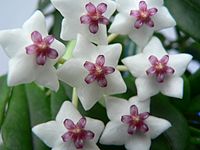
Photo from wikipedia
Abstract Global pollinator declines have fostered increased public interest in creating pollinator-friendly gardens in human-managed landscapes. Indeed, studies on urban pollinator communities suggest that flower-rich greenspaces can serve as promising… Click to show full abstract
Abstract Global pollinator declines have fostered increased public interest in creating pollinator-friendly gardens in human-managed landscapes. Indeed, studies on urban pollinator communities suggest that flower-rich greenspaces can serve as promising sites for conservation. Ornamental flowers, which are readily available at most commercial garden centers, are ubiquitous in these landscapes. These varieties are often non-native and highly bred, and their utility to pollinators is complex. In this study, we used observational data and citizen science to develop a methods framework that will assist stakeholders in the floriculture industry to incorporate metrics of pollinator health into existing breeding and evaluation protocols. The results of this study support how plant attractiveness to pollinators is often dependent on variables such as climate and plant phenology, which should be considered when developing an assessment tool. Furthermore, we found that some cultivars were consistently attractive across all observations while for other cultivars, pollinator visitation was apparently conditional. We determine using multiple statistical tests that 10 min is a sufficient length of time for observation of most plant types to broadly estimate three measures of plant attractiveness: visitor abundance, primary visitors attracted, and cultivar rank attractiveness, without sacrificing efficiency or accuracy. Additionally, we demonstrate that properly trained non-expert observers can collect accurate observational data, and our results suggest that protocols may be designed to maximize consistency across diverse data collectors.
Journal Title: Journal of Economic Entomology
Year Published: 2022
Link to full text (if available)
Share on Social Media: Sign Up to like & get
recommendations!